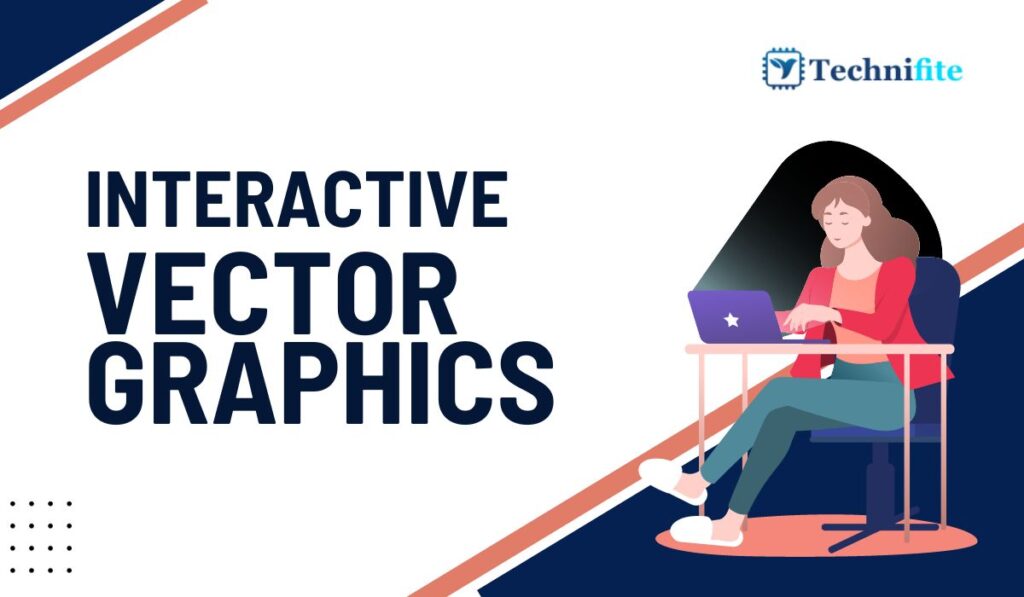Interactive Vector Graphics: In digital design, static images give way to dynamic, interactive experiences. The evolution of technology and the increasing demand for engaging user interfaces have ushered in a new era of creativity—interactive vector graphics. Powered by animation, these graphics breathe life into designs, creating immersive and captivating user experiences. In this in-depth exploration, we venture into the world of interactive vector graphics, unravelling the techniques, tools, and creative possibilities that come to life when designs move and respond.
Understanding the Power of Interactive Vector Graphics
Interactive vector graphics combine the versatility of vector design with the dynamic nature of animation. Unlike traditional static graphics, interactive vector graphics respond to user actions, creating a sense of participation and engagement. Through animations, vector elements can transform, move, and interact with users, making the digital experience more intuitive, enjoyable, and memorable. The integration of interactivity enhances user interfaces, websites, mobile apps, educational platforms, and games, bridging the gap between imagination and reality.
The Core Principles of Interactive Vector Animation
1. Fluidity and Smooth Transitions
One of the hallmarks of exceptional interactive vector animation is fluidity. Smooth transitions between states, movements, and interactions create a seamless and visually appealing experience. With their mathematical precision, vector graphics allow for fluid animations that flow effortlessly, enhancing the overall user immersion. Whether it’s a subtle fade-in effect or a complex interactive narrative, fluid animations captivate the audience and make the digital interface come alive.
2. Interactivity and User Engagement
Interactivity lies at the heart of interactive vector graphics. Users crave engaging experiences where their actions have consequences. Interactive animations respond to user input, such as clicks, swipes, or scrolls, providing instant feedback and guiding users through the digital environment. Interactive vector graphics can include interactive infographics, responsive websites, interactive storytelling, gamified applications, and interactive product demonstrations. By engaging users actively, these animations create memorable experiences that resonate long after the interaction.
3. Storytelling through Motion
Animation has a unique ability to convey narratives and emotions. Interactive vector graphics leverage this power, allowing designers to tell stories through motion. By orchestrating sequences of animations, designers can guide users through a journey, evoke emotions, and communicate complex ideas effectively. Whether it’s a scrolling infographic that unfolds a story step by step or an interactive game that immerses users in a narrative world, motion adds depth and meaning to the user experience.
4. Performance Optimization
While creativity knows no bounds, practical considerations such as performance optimization are crucial in interactive vector animation. Optimized animations ensure smooth playback across various devices and screen sizes, enhancing the user experience regardless of the user’s hardware. Techniques such as sprite sheets, lazy loading, and efficient code structure are essential in achieving seamless animations without compromising performance. Striking a balance between creativity and performance ensures that interactive vector graphics are accessible and enjoyable for a wide audience.
Tools and Technologies in Interactive Vector Animation
1. Vector Animation Software
Various vector animation software tools empower designers to create interactive vector graphics. Adobe Animate, a popular choice, offers a comprehensive platform for vector-based animations. Its intuitive interface, robust animation features, and support for interactivity make it a go-to tool for many designers. Tools like SVGator and Haiku Animator also enable designers to create interactive animations directly from vector graphics, simplifying the animation process and enhancing workflow efficiency.
2. Scalable Vector Graphics (SVG) and JavaScript
Scalable Vector Graphics (SVG) is the foundation for many interactive vector animations. SVG, an XML-based vector image format, is resolution-independent and can be manipulated using CSS and JavaScript. JavaScript libraries like GreenSock Animation Platform (GSAP) and Snap.svg provide powerful animation capabilities, allowing designers to create interactive elements, transitions, and complex animations. Designers can create highly interactive and visually appealing experiences by combining SVG graphics with JavaScript.
3. WebGL for Complex 3D Interactions
WebGL technology is instrumental for advanced interactive vector graphics involving 3D animations and complex interactions. WebGL, a JavaScript API for rendering interactive 3D and 2D graphics, leverages the power of the computer’s GPU to create high-performance visuals. Libraries like Three.js simplify the implementation of complex 3D animations, enabling designers to craft immersive experiences with interactive 3D models, dynamic lighting, and realistic textures. WebGL-based interactive vector graphics find applications in interactive data visualization, virtual reality experiences, and advanced gaming interfaces.
Creative Applications of Interactive Vector Graphics
1. Interactive Infographics and Data Visualization
Interactive infographics transform static data into engaging narratives. By animating data points, charts, and graphs, interactive infographics allow users to explore information dynamically. Users can interact with specific data points, reveal additional details on hover, and even manipulate variables to see real-time changes. Interactive data visualization educates users and keeps them engaged, enhancing their understanding of complex topics.
2. Gamification and Interactive Learning
Games and interactive learning platforms leverage the power of interactive vector graphics to create immersive experiences. Gamification elements, such as animated characters, interactive challenges, and reward animations, enhance user engagement and motivation. Interactive learning platforms use animations to guide users through lessons, simulate real-world scenarios, and provide interactive quizzes. By combining education with entertainment, interactive vector graphics make learning enjoyable and effective.
3. Interactive Web Design and User Interfaces
Websites and web applications are embracing interactive vector graphics to create visually appealing and intuitive user interfaces. Interactive elements, such as animated buttons, navigational transitions, and interactive menus, enhance user experience and encourage exploration. Microinteractions are subtle animations that respond to user actions, provide feedback and create a delightful browsing experience. Interactive vector graphics also find applications in interactive prototypes for user testing, allowing designers to simulate user interactions and gather valuable feedback.
4. Augmented Reality (AR) and Virtual Reality (VR) Experiences
Interactive vector graphics are pivotal in augmented reality (AR) and virtual reality (VR) experiences. In AR applications, vector-based overlays add interactive elements to the real world, enhancing the user’s perception of the environment. Interactive vector graphics in VR environments create immersive worlds where users can interact with objects, navigate spaces, and engage with virtual characters. These experiences blur the line between the digital and physical worlds, offering users a truly immersive and interactive adventure.
The Future of Interactive Vector Graphics: Challenges and Innovations
As interactive vector graphics continue to evolve, designers face challenges related to compatibility, performance, and user accessibility. Ensuring seamless experiences across various devices and platforms, optimizing performance for resource-intensive animations, and making interactive designs accessible to users with disabilities are ongoing challenges. Designers and developers are continually exploring innovative solutions, such as using artificial intelligence for responsive animations and integrating haptic feedback to enhance user immersion.
Innovations in interactive vector graphics are also driven by emerging technologies such as the Internet of Things (IoT) and wearable devices. Interactive vector graphics find applications in IoT interfaces, enabling users to interact with smart devices seamlessly. Wearable devices, equipped with sensors and interactive displays create new opportunities for immersive and responsive vector-based animations. Fusing interactive vector graphics with these technologies opens new frontiers for creativity and user experience design.
Conclusion: The Dynamic Future of Interactive Vector Graphics
Interactive vector graphics have redefined the way we engage with digital content. From interactive infographics that educate and inform to immersive virtual reality experiences that transport users to different worlds, interactive vector graphics are shaping the future of digital interaction. As technology advances, the boundaries of creativity in interactive vector graphics are limitless. Designers and developers, armed with innovative tools and techniques, craft interactive experiences that captivate, educate, and inspire.
In the dynamic digital design landscape, interactive vector graphics stand at the forefront of innovation. They represent a visual evolution and a transformation in how we interact with information, entertainment, and each other. As interactive vector graphics expand, one thing is certain: the future holds a world where creativity knows no bounds, and every interaction is an opportunity for a captivating, interactive experience.
Frequently Asked Questions (FAQs)
What are interactive vector graphics, and how do they differ from static vector graphics?
Interactive vector graphics are dynamic digital designs that respond to user actions such as clicks, taps, or scrolls. Unlike static vector graphics, which remain fixed, interactive vector graphics allow users to engage with the elements, creating a dynamic and immersive user experience. Interactivity adds layers of engagement, making the design responsive to user input and enhancing user satisfaction.
How are interactive vector graphics created, and what tools are commonly used for development?
Interactive vector graphics are typically created using vector graphic software like Adobe Animate, SVGator, or Haiku Animator. These tools allow designers to create vector-based animations and add interactive elements. JavaScript is often combined with Scalable Vector Graphics (SVG) to enable interactivity. Libraries like Three.js are employed for creating interactive 3D vector graphics, especially in augmented reality (AR) and virtual reality (VR) applications.
In what contexts can interactive vector graphics be applied?
Interactive vector graphics find applications in various contexts, including websites, mobile applications, e-learning platforms, interactive infographics, games, augmented reality (AR) and virtual reality (VR) experiences, user interfaces for IoT devices and digital presentations. Their ability to engage users and enhance user experience makes them valuable in any digital interface where interactivity is desired.
How does performance optimization impact the user experience of interactive vector graphics?
Performance optimization is crucial for interactive vector graphics, ensuring smooth animations and responsive interactions. Techniques such as sprite sheets, lazy loading, and efficient code structures are used to optimize performance. Well-optimized graphics enhance user satisfaction by providing seamless experiences, especially on devices with varying processing power and screen sizes.
What role does accessibility play in interactive vector graphics, and how can designers ensure inclusivity?
Accessibility is vital in interactive vector graphics to ensure that users with disabilities can access the content equally. Designers must consider factors such as colour contrast, keyboard navigation, screen reader compatibility, and providing alternative text for non-text elements. Adhering to web accessibility guidelines (such as WCAG) ensures that interactive vector graphics are inclusive and usable by all, regardless of their abilities or disabilities.


